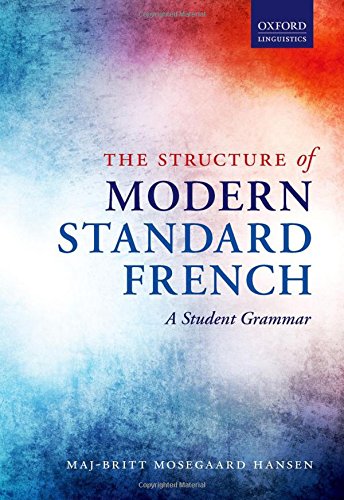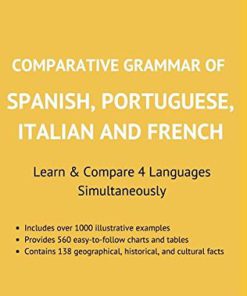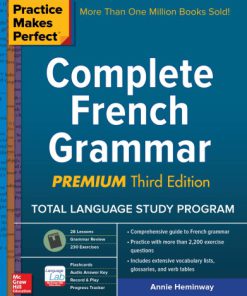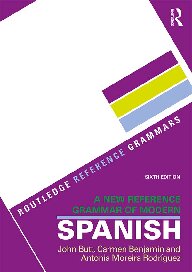The Structure of Modern Standard French A Student Grammar 1st edition by Maj Britt Mosegaard Hansen 9780191035685 0191035688
$50.00 Original price was: $50.00.$25.00Current price is: $25.00.
The Structure of Modern Standard French A Student Grammar 1st edition by Maj Britt Mosegaard Hansen – Ebook PDF Instant Download/Delivery: 9780191035685, 0191035688
Full download The Structure of Modern Standard French A Student Grammar 1st edition after payment

Product details:
• ISBN 10:0191035688
• ISBN 13:9780191035685
• Author:Maj Britt Mosegaard Hansen
The Structure of Modern Standard French
A Student Grammar
This book is an advanced student’s grammar of French that integrates traditional grammar with knowledge and insights from modern linguistics. Maj-Britt Mosegaard Hansen takes a structural approach to French grammar: she provides clear descriptions of grammatical rules based explicitly on syntactic structure, and places descriptive emphasis on instances where the grammatical structures of French differ from those used in corresponding contexts in English. The first part of the book provides an introduction to French sentence structure, before the following parts examine the grammar of verbs, nominals, particles, and clauses and sentences. The Structure of Modern Standard French will be a valuable resource for students of French at undergraduate level and beyond. It assumes some prior knowledge of French grammar but is designed to be accessible to those with no background in linguistics.
The Structure of Modern Standard French A Student Grammar 1st Table of contents:
Part I: Understanding French Sentence Structure
1: Simple sentences and their basic constituents
1.1 The notion of grammatical structure
1.2 Central grammatical constituents of simple sentences
1.2.1 The predicator
1.2.1.1 Valency
1.2.2 The subject
1.2.3 The complements
1.2.3.1 The subject attribute
1.2.3.2 The direct object
1.2.3.3 The measure complement
1.2.3.4 The prepositional object
1.2.3.5 The dative object
1.2.3.6 Prepositional objects vs dative objects
1.2.3.7 The locative object
1.2.3.8 The object attribute
1.2.3.9 Structures with two complements
1.2.3.10 One verb-more than one valency pattern
1.2.4 Adverbials
1.3 Conclusion
2: The internal structure of clause constituents
2.1 The distinction between function and form in language
2.2 Word classes in French
2.2.1 Verbs
2.2.2 Nominals
2.2.3 Particles
2.3 Hierarchically structured phrase types
2.3.1 Compound verbs
2.3.2 Noun phrases
2.3.3 Adjective phrases
2.3.4 Adverb phrases
2.3.5 Pronominal phrases
2.4 Non-hierarchically structured phrases
2.4.1 Prepositional phrases
2.5 Relations of coordination
2.6 Tests for determining the nature and extension of a given phrase and its syntactic function
2.6.1 Substitution
2.6.2 Elimination
2.6.3 Coordination
2.6.4 Insertion and movement
2.6.5 Blocking
2.6.6 Agreement
2.7 Conclusion
3: Complex sentence structures
3.1 Grammatical and `logical´ elements
3.1.1 Passive clauses
3.1.2 Anticipatory and postponed subjects
3.2 Subordinate clauses and reduced clauses
3.2.1 Subordination in grammar
3.2.1.1 Subordinate clauses vs coordinated clauses
3.2.2 Non-finite clauses
3.2.3 Absolute constructions
3.2.4 Free indirect attributes and appositions
3.2.4.1 Free indirect attributes
3.2.4.2 Appositions
3.3 Conclusion
4: Subordinate clauses
4.1 Introduction
4.2 Types of subordinate clauses
4.2.1 Nominal clauses
4.2.1.1 Complement clauses
4.2.1.2 Indirect interrogative clauses
Yes/no interrogatives
WH-interrogatives
4.2.1.3 Free relative clauses
4.2.2 Adjectival clauses
4.2.2.1 Restrictive relative clauses
4.2.2.2 Non-restrictive relative clauses
Sentential relative clauses
4.2.2.3 Predicative relative clauses
4.2.3 Adverbial clauses
4.2.3.1 Conjunctions introducing adverbial clauses
4.2.3.2 Subtypes of adverbial clauses
Temporal clauses
Causal clauses
Conditional clauses
Concessive clauses
Purpose clauses
Result clauses
Comparison clauses
Modal clauses
4.3 Conclusion
Part II: The Grammar of French Verbs
5: Finite verb forms: Mood
5.1 Introduction
5.2 The indicative
5.3 The imperative
5.4 The subjunctive
5.4.1 The subjunctive in independent clauses
5.4.2 The subjunctive in nominal clauses
5.4.2.1 Preposed complement clauses
5.4.2.2 Complement clauses as postponed subjects
Expressions of volition or desire
Expressions of subjective evaluation
5.4.2.3 Complement clauses as direct objects or as complements of prepositions
Expressions of volition or desire
Expressions of subjective evaluation
Expressions of doubt or denial
Verbs of saying or opinion
Verbs of ambiguous modality
5.4.2.4 Complement clauses as subject attributes
The subject is an expression of volition or desire
The subject expresses a subjective evaluation
5.4.3 The subjunctive in adjectival clauses
5.4.3.1 Restrictive relative clauses
Indefinite antecedent
Antecedent in the superlative
5.4.4 The subjunctive in adverbial clauses
5.4.4.1 Temporal clauses
5.4.4.2 Causal clauses
5.4.4.3 Conditional clauses
5.4.4.4 Concessive clauses
5.4.4.5 Purpose clauses
5.4.4.6 Result clauses
5.4.4.7 Comparison clauses
5.4.4.8 Modal clauses
5.4.5 Use of the indicative where the subjunctive would be expected
6: Finite verb forms: Tense
6.1 Introduction
6.1.1 Tense as a deictic category
6.2 Primary tenses
6.2.1 The present tense
6.2.1.1 The inclusive use of the présent
6.2.2 The past tenses
6.2.3 The simple future tense
6.2.3.1 Modal uses of the futur simple
6.3 Secondary tenses
6.3.1 The present perfect
6.3.2 The past perfect
6.3.3 The compound future tense
6.3.4 The future perfect
6.3.4.1 Modal use of the futur antérieur
6.3.5 The future in the past tense
6.3.5.1 Modal uses of the conditionnel
6.3.6 The future perfect in the past
6.3.6.1 Modal uses of the conditionnel passé
6.4 Tense in conditionals
6.4.1 Real conditionals
6.4.2 Potential conditionals
6.4.3 Unreal (or counterfactual) conditionals
6.4.4 Tense use after au cas où, pour le cas où, dans le cas où
6.5 Tense in (free) indirect speech and thought
7: Finite verb forms: Aspect
7.1 Introduction
7.2 Mode of action
7.3 Choice of aspect: General principles
7.4 Typical patterns of aspectual use in connection with adverbials and subordinate clauses
7.4.1 Adverbials
7.4.1.1 Adverbials that normally trigger the imparfait
Present-time adverbials
Adverbials that describe on-going activity
Iterative adverbials, when they describe an indefinite number of repetitions
7.4.1.2 Adverbials that normally trigger the passé simple
Limitative adverbials
Iterative adverbials, when they describe a definite number of repetitions
7.4.1.3 Other types of temporal adverbials
7.4.1.4 Clauses containing two or more different types of adverbial
7.4.2 Subordinate clauses
7.4.2.1 Nominal clauses
7.4.2.2 Adjectival clauses
Predicative relative clauses
Restrictive relative clauses
Non-restrictive relative clauses
7.4.2.3 Adverbial clauses
Temporal clauses introduced by quand or lorsque
Temporal clauses introduced by comme, alors que, pendant que, or tandis que
Temporal clauses introduced by dès que, aussitôt que, or tant que
Clauses of cause, comparison, or concession
Result clauses
Other types of adverbial clause
8: Finite verb forms: Auxiliaries
8.1 The notion of auxiliary
8.2 Être and avoir as tense/aspect auxiliaries
8.2.1 Transitive verbs used non-reflexively
8.2.2 Pronominal verbs and reflexive constructions
8.2.3 Intransitive verbs: The general rule
8.2.4 Intransitive verbs: The exceptions
9: Non-finite verb forms: The infinitive
9.1 Introduction
9.2 Infinitival clauses
9.2.1 Infinitival clauses with predominantly verbal function
9.2.1.1 Absolute constructions
9.2.1.2 Clause fragments
9.2.2 Infinitival clauses with predominantly nominal function
9.2.2.1 Infinitive markers vs prepositions
9.2.2.2 The use or non-use of infinitive markers
Infinitival clauses as (dislocated) subjects
Infinitival clauses as postponed subjects
Infinitival clauses as subject attributes
Infinitival clauses as direct objects
Infinitival clauses as complements of prepositions
Infinitival clauses as purpose adverbials following a motion verb
Infinitival clauses as object attributes or free indirect attributes
10: Non-finite verb forms: The past participle
10.1 The past participle
10.2 Verbal use of the past participle
10.2.1 Past participle agreement
10.2.1.1 The subject rule
10.2.1.2 The direct object rule
Pronominal verbs and reflexive constructions
Transitive constructions
Constructions with (se) faire and se voir
10.3 Past participle clauses
10.3.1 The structure of past participle clauses
10.3.2 The functions of past participle clauses
10.3.2.1 Verbal use
10.3.2.2 Adjectival use
10.4 Nominal use of the past participle
11: Non-finite verb forms: The present participle and the gérondif
11.1 Introduction
11.2 Deverbal adjectives ending in -ant
11.3 The present participle
11.3.1 Present participles with predominantly verbal function
11.3.2 Present participles with predominantly adjectival function
11.4 Deverbal nouns ending in -ant
11.5 The gérondif
Part III: The Grammar of French Nominals
12: Definite and indefinite determiners
12.1 Introduction
12.2 Definiteness and indefiniteness
12.3 Indefinite articles
12.3.1 The partitive article
12.3.1.1 The full partitive article
12.3.1.2 The reduced partitive article
Direct objects following a negated predicator
Postponed subjects following a negated predicator
The exception: subject attributes following a negated predicator
The noun phrase contains a premodifying plural adjective
12.3.2 The zero article
12.3.2.1 The noun phrase functions as a subject attribute
12.3.2.2 The noun phrase functions as an object attribute, a free indirect attribute, or an appositi
12.3.2.3 The noun phrase is the complement of a preposition
12.3.2.4 Coordinated noun phrases
12.4 The definite article
12.4.1 Generic use of the definite article
13: Adjectives within the noun phrase
13.1 The forms of French adjectives
13.1.1 Adjectives with irregular masculine forms
13.1.2 Degree marking
13.2 The use of adjectives within the noun phrase
13.3 The position of modifying adjectives
13.3.1 Normally premodifying adjectives
13.3.2 Normally postmodifying adjectives
13.3.3 `Unusual´ word orders
13.3.3.1 Normally premodifying adjectives in postmodifying position
13.3.3.2 Normally postmodifying adjectives in premodifying position
Distinct meaning difference between pre- and postmodifying position
Weakening of the meaning of a normally postmodifying adjective to resemble that of a normally premod
Weakening of the meaning of a normally postmodifying adjective to resemble that of a determiner
Use of a normally postmodifying adjective to describe a supposedly natural or inherent property of t
13.4 More than one modifier within a noun phrase
13.4.1 Two or more adjectives within a noun phrase
13.4.1.1 Relative position
13.4.1.2 Number agreement
13.4.2 Adjectives in compound-like noun phrases
14: Pronouns: Overview
14.1 Introduction
14.2 Genuine vs clitic pronouns
14.3 Pronouns vs articles
14.4 Deixis and anaphoricity
14.5 Genitives
14.5.1 Possessive genitives
14.5.2 Subjective and objective genitives
14.5.3 Partitive genitives
14.5.4 Pronouns and articles with genitive meaning
15: Personal and reflexive pronouns
15.1 Personal vs reflexive pronouns
15.2 The personal clitics
15.2.1 Case inflection
15.2.2 The relative position of personal clitics
15.2.3 The generic clitic on
15.3 Non-clitic personal pronouns
15.4 Reflexive pronouns
15.4.1 Uses of the reflexive construction in French
15.4.1.1 Standard reflexive use
15.4.1.2 Reciprocal use
15.4.1.3 Passive use
16: Neutral pronouns
16.1 Introduction
16.2 The neutral pronoun is the subject of the clause
16.2.1 Cela and ceci
16.2.2 Ce
16.2.3 Il
16.3 The neutral pronoun is an anticipatory subject
16.3.1 The clause contains a non-reflexive direct object
16.3.2 The clause contains a subject attribute
16.3.3 The postponed subject is a complement clause or an infinitival phrase
16.3.4 The postponed subject is a noun phrase
16.4 Different functions of neutral pronouns with the same verb
16.5 The neutral pronoun is a complement
16.5.1 Translation of the English anticipatory direct object construction into French
17: Pronominal adverbs
17.1 Introduction
17.2 En
17.2.1 En represents a prepositional phrase
17.2.1.1 En as a prepositional object
17.2.1.2 En as a postmodifier of quantifying expressions (nouns or adverbs)
17.2.1.3 En as a genitive postmodifier of a noun phrase
17.2.1.4 En as a postmodifier of an adjective phrase
17.2.1.5 En as a locative object or adverbial
17.2.2 En represents (the head of) an indefinite noun phrase
17.2.3 En in frozen expressions
17.3 Y
17.3.1 Y represents a prepositional phrase
17.3.1.1 Y as a prepositional object
17.3.1.2 Y as a locative object or adverbial
17.3.1.3 Y as a postmodifier of an adjective phrase
17.3.2 Y in frozen expressions
18: Possessives and demonstratives
18.1 Possessives
18.1.1 Possessive articles
18.1.2 Possessive pronouns
18.2 Demonstratives
18.2.1 The demonstrative article
18.2.1.1 Deictic use of the demonstrative article
18.2.1.2 Non-deictic uses of the demonstrative article
Anaphoric use
Cataphoric use
18.2.2 Demonstrative pronouns
19: Interrogative and relative pronouns and adverbs
19.1 Introduction
19.2 Interrogative pronouns and adverbs
19.2.1 Interrogative pronouns in independent clauses
19.2.1.1 The interrogative pronoun is the subject of the clause
19.2.1.2 The interrogative pronoun is a direct object
19.2.1.3 The interrogative pronoun is the complement of a preposition
19.2.1.4 The interrogative pronoun is a subject attribute
19.2.1.5 The interrogative article quel
19.2.1.6 The interrogative pronoun lequel
19.2.1.7 Interrogative adverbs
19.2.2 Interrogative pronouns in subordinate clauses
19.2.2.1 The referent is human
19.2.2.2 The referent is non-human
19.3 Relative pronouns and adverbs
19.3.1 The relative pronoun is the subject
19.3.2 The relative pronoun is a direct object or a subject attribute
19.3.3 The relative pronoun is the complement of a preposition
19.3.3.1 The relative pronoun is governed by a preposition other than de
The antecedent is human
The antecedent is non-human
The antecedent is a whole clause, a neutral pronoun, or an indefinite pronoun
19.3.3.2 The relative pronoun is governed by the preposition de
19.3.4 The forms ce qui, ce que, ce dont, ce + preposition + quoi
19.3.5 The relative pronoun or adverb functions as an adverbial
19.3.5.1 A relative adverb functions as a locative adverbial
19.3.5.2 A relative pronoun/adverb functions as a temporal adverbial
20: Indefinites
20.1 Introduction
20.2 Quantifying indefinites
20.2.1 Certain(e)(s)
20.2.2 Différent(e)(s) and divers(es)
20.2.3 Plusieurs
20.2.4 Quelque(s), quelqu´un(e), quelques-un(e)s, and quelque chose
20.2.5 Un(e)(s)
20.3 Indefinites with holistic or distributional meanings
20.3.1 Tout(e)(s) and tous
20.3.2 Chaque and chacun(e)
20.4 Adjective-like indefinites
20.4.1 Autre(s) and autrui
20.4.2 Même(s)
20.4.3 Tel(le)(s)
Part IV: The Grammar of French Particles
21: Prepositions
21.1 Introduction
21.2 Criteria for classifying prepositions
21.2.1 Meaning
21.2.2 Form
21.2.3 Functional range
21.2.4 Form + meaning
21.2.4.1 Light prepositions
21.2.4.2 Heavy prepositions
21.3 General principles for choosing among different prepositions
21.3.1 The role of determiners and modifiers in the complement
21.3.2 Syntactic distance
21.3.3 Prepositional phrases as postmodifiers vs adverbials
21.3.4 Locative prepositions: static vs dynamic senses
21.4 The syntax of prepositions
21.4.1 The position of prepositions
21.4.2 Repetition of prepositions
21.4.3 Non-use of prepositions in French
22: Adverbs, interjections, and coordinating conjunctions
22.1 Adverbs
22.1.1 The formation of derived adverbs
22.1.2 Comparative and superlative forms of adverbs
22.1.3 Adverbs of degree and quantity
22.1.4 Adverbs of time and place
22.1.4.1 Deictic vs non-deictic time adverb(ial)s
22.1.4.2 Ici, là, and là-bas
22.1.4.3 Expressing directional motion in French vs English
22.2 Interjections
22.2.1 Definition
22.2.2 The response words oui, si, and non
22.3 Coordinating conjunctions
22.3.1 Et, ou (bien), and soit
22.3.2 Mais and car
Part V: The Grammar of French Clauses and Sentences
23: Negation and restriction
23.1 Introduction
23.2 Clause negation
23.2.1 The second negator
23.2.1.1 General negation
The position of general negators
Negative ne
23.2.1.2 N-word negation
N-words in non-negative contexts
23.2.1.3 The relative positions of second clause negators
23.2.2 The negative coordinating conjunction ni
23.3 Constituent negation
23.4 Expletive ne
23.5 Restriction
24: Word order
24.1 Introduction
24.2 Topology
24.3 Types of inversion in French
24.3.1 Complex inversion
24.3.2 Simple inversion
24.3.3 Stylistic inversion
24.4 Inversion in direct interrogatives
24.4.1 Yes-no interrogatives
24.4.2 WH-interrogatives
24.4.3 Alternatives to inversion in direct interrogatives
24.5 Inversion in non-interrogative independent clauses
24.5.1 Complex inversion
24.5.1.1 Alternatives to complex inversion after conjunctive adverbials
24.5.2 Simple inversion
24.5.3 Stylistic inversion
24.6 Inversion in subordinate clauses
24.7 The position of adverbials
24.7.1 Types of non-focalizable adverbials
24.7.1.1 Stance adverbials
24.7.1.2 Indefinite time adverbials
24.7.1.3 Adverbials of degree and quantity
24.7.1.4 Negative adverbials
24.7.1.5 Non-focalizable manner adverbials
24.7.1.6 The relative position of non-focalizable adverbials
25: Voice
25.1 Introduction
25.2 The passive voice
25.2.1 The canonical passive in French
25.2.1.1 Possible interpretations of être + past participle
25.2.1.2 Expressing the logical subject in a passive construction
25.2.2 Alternatives to the canonical passive
25.3 The middle voice and the reflexive passive
25.3.1 The standard reflexive construction
25.3.2 The reflexive passive
25.4 The causative voice
25.4.1 The grammatical realization of the logical subject in the causative voice
25.4.1.1 Laisser + infinitive and verbs of perception + infinitive
25.4.2 Reflexive causatives with passive meaning
26: Dislocation, (pseudo-)clefts, and presentative constructions
26.1 Information flow and `canonical´ clause/sentence structure
26.2 Left- and right-dislocation
26.3 Cleft and pseudo-cleft sentences
26.3.1 Cleft sentences
26.3.2 Pseudo-cleft sentences
26.4 Presentative constructions
Appendix A: Overview of grammatical functions
Appendix B: Word classes in French
Appendix C: Subordinate clause types in French
Appendix D: Examples of sentence analyses to word level (function/form)
Appendix E: Overview of the French tenses
Further reading
Index
People also search forThe Structure of Modern Standard French A Student Grammar 1st:
the structure of modern
explain the structure of modern periodic table
hugo friedrich the structure of modern poetry
write the structure of modern periodic table
discovering language the structure of modern english
You may also like…
Languages - French Language Reference
Glossika Guide to French Pronunciation and Grammar 1st Edition Clément Hattiger
Children's Books - Education & Reference
Politics & Philosophy - Anthropology
Languages - Comparative Studies
Languages - French Language Reference
dictionaries & phrasebooks
The Cambridge Grammar of Medieval and Early Modern Greek David Holton












